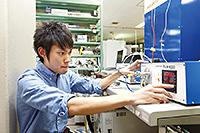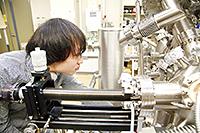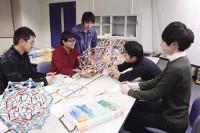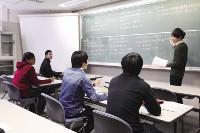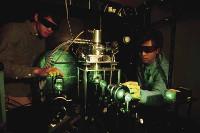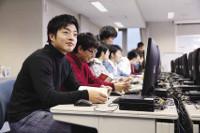- Mathematics and Physics (website by the department)
Course
Mathematical Science Course
Students learn systematically basic mathematical theory and engage in practical exercises such as mathematical model analysis and data analysis so that they develop skills of solving problems in natural and social systems.
Materials Physics and Astrophysics Course
This course focuses on the fields of functional materials physics and astrophysics, and provides education to promote interest in the fundamental laws of nature and their practical application in industry and society.
Applied Computational Science Course
Students learn basic mathematics, physics, and information science with the aim to understand social phenomena and to solve problems of social and economical systems.
Voice of undergraduate
Staff List
Mathematics
| Name | Position | Specialty | Research Content |
|---|---|---|---|
| KON, Masamichi | Professor | Operations Research | Planning mathematics are used to solve various social problems. Methods to do so, and the establishment and application of mathematical theories are studied. |
| SAKAKI, Makoto | Professor | Geometry | Study of the geometry of curves, surfaces, and normed spaces. |
| TSUTAYA, Kimitoshi | Professor | Mathematical analysis | Study of the existence of solutions of nonlinear wave equations appearing in relativistic quantum mechanics and gauge theories using functional analysis methods |
| BETSUMIYA, Koichi | Professor | Algebraic Combinatorics, Coding Theory | Aim to discover and understand unknown combination structures, focusing on error-correcting code structures which are used in communication theory |
| MORI, Shintaro | Professor | Statistics / Probabilistic model | Statistical modeling of social and economic phenomena and study of the mechanisms of collective intelligence |
| EI, Hiromi | Associate Professor | Ergodic Theory | Study of discrete dynamical systems determined by various functions (especially substitution rules of letters), and tilings with fractals |
| TACHIYA, Yohei | Associate Professor | Transcendental Number Theory | Study of special values of analytic functions which are especially important in number theory. We aim to understand the arithmetical properties of those values by algebraic and analytic methods |
| NAGASE, Noriaki | Associate Professor | Stochastic Theory, Wavelet Analysis | Development of functions using a wavelet base, with the aim of approaching the original function using part of the occurring small wave |
| KAWASAKI, Naho | Assistant Professor | Number Theory | Study of properties that hold for multiple zeta values and their analogues We aim to find new relations among multiple zeta values |
| MIURA, Tatsuhiko | Assistant Professor | Mathematical analysis | Study of properties of solutions to fluid and diffusion equations in thin domains or on surfaces |
Physics
| Name | Position | Specialty | Research Content |
|---|---|---|---|
| ASADA, Hideki | Professor | Theoretical Astrophysics, especially General Relativity and Cosmology (Gravitational Lens, Gravitational Waves, Dark Matter, Dark Energy). |
Theoretical study of the universe, particularly the matter, energy and structure by using a gravitational theory such as the theory of general relativity. |
| GORYO, Jun | Professor | Theoretical condensed matter physics, mainly, superconductuvity…etc | Theoretical study of superconductivity, topological aspects of condensed matter physics, gauge field theories, and so on. |
| SENDOUDA, Yuuiti | Professor | Theoretical physics, cosmology and gravity | Theoretical studies of the origin and evolution of our universe and its governing physical laws via searches for hypothetical remnants of the primordial universe such as black holes and gravitational waves |
| FUJIKAWA, Yasunori | Professor | Structural analysis and property measurement on surfaces, thin films and nanostructures by means of multi-probe STM | Microscopic studies on next-generation nanoelectronics materials, such as graphene. |
| MIYANAGA, Takafumi | Professor | Condensed Matter Physics / Materials Science. Structural Dynamics (Phase Transitions, Chemical Reactions, Surface Processes, Nonequilibrium states), XAFS / Synchrotron Radiation. |
Since the research field is not specified, various subjects such as semi-conductors, magnetic bodies and superconductors can be studied. Structures using synchrotron radiation and electronic state analysis method are challenged. |
| AZUHATA, Takashi | Associate Professor | Optical Properties of Semiconductors. | Study of optical characteristics of a wide-bandgap semiconductor and application devices |
| ENTA, Yoshiharu | Associate Professor | Atomic Structures, Electronic Structures, and Chemical Reactions on Semiconductor Surface/Interface. | Study of physicochemical reactions at the atomic level which occur on solid surfaces and interfaces is carried out to improve functionality of semi-conductor devices and the develop new materials. |
| SUZUKI, Yuushi | Associate Professor | Interface Science of Materials Surface Vibrational Spectroscopy Low-Dimensional Low-energy Physics. | Study of optical properties of nanoparticle arrays using electron lithography and nanoparticles using zeolite micropores |
| TEZUKA, Yasuhisa | Associate Professor | X-ray Spectroscopic Studies on Electronic State of Dielectrics and Strongly Correlated Materials. | Electron structures of dielectrics and functional substances are studied using X-ray emission and X-ray scatterings, etc., while performing experiments in Tsukuba, etc. |
| MASUDA, Ryo | Associate Professor | Condensed matter physics using synchrotron radiation Mössbauer spectroscopy | Local electronic/vibrational states of various functional materials using partcle beams, mainly synchrotron radiation and gamma-rays from radioactive isotopes. |
| KUGA, Kentaro | Assistant Professor | Thermal Energy Conversion | Study of the conversion of heat into electricity by developing high-performance thermoelectric materials, investigating the origins, and creating devices. |
| NOMURA, Mariko | Assistant Professor | Theoretical astrophysics | Study on high-energy astronomical phenomena induced by black holes by using numerical simulations. |

